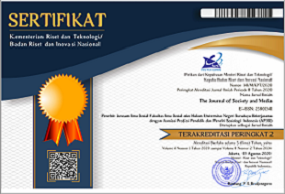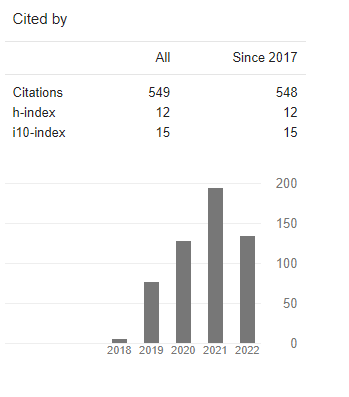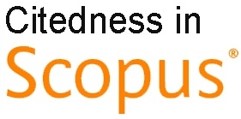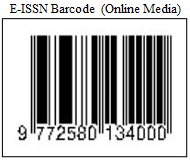Beauty Vloggers Hegemonize Student Behavior as the Beauty Vlog Viewers and Cosmetic Consumers
DOI:
https://doi.org/10.26740/jsm.v5n2.p271-284Keywords:
hegemony, vlogger, beauty, gramsci, vlog-viewerAbstract
Beauty vloggers and viewers become interesting business when cosmetic industry grows rapidly in Indonesia. Digital media are the most significant reason for the global cosmetic production, marketing and consumption reaching global society, especially female students. With limited funds, they should not always watch beauty vlog and buy cosmetics staffs. In facts, they are not aware of being consumers than being owners on beauty and cosmetic products businesses. The objective is to analyze the processes and impacts of the hegemony of beauty vlogger on students consuming cosmetics at Sebelas Maret University, Surakarta. We used Antonio Gramsci's hegemony theory. With qualitative approach, we collected data with interview students’ knowledges on cosmetic products and preferable vloggers or actors, observed students watching vlog, and documented membership, consumable beauty products discussion selected by 30 students as viewer/users. The validity of data used triangulation of sources and methods and then analyzed with Miles & Huberman technique. The results showed that the beauty vloggers hegemonize students’ viewers in several strategies: (1) increasing knowledge on cosmetics products and usages, (2) building trust to gain viewer’s sympathy, (3) intensifying communication with viewers, (4) creating local representatives for make-up and beauty, (5) regularly updating cosmetics data, inspiratory beauty creativity, and sale self-confidence. More students become beauty vlog viewers and users than beauty and cosmetic entrepreneurship owners.
References
BPOM. 2010. Peraturan Kepala Badan Pengawas Obat Dan Makanan Republik Indonesia Nomor HK.03.1.23.12.10.11983 Tahun 2010 Tentang Kriteria Dan Tata Cara Pengajuan Notifikasi Kosmetika. Berita Negara Republik Indonesia, (598). Diperoleh pada 29 April 2020 dari https://www.google.com/url?sa=t&source=web&rct=j&url=http://jdih.pom.go.id/showpdf.php%3Fu%3D8&ved=2ahUKEwj1ze3Ur7nqAhWU4HMBHUmqC6cQFjABegQIBBAC&usg=AOvVaw1fTRMIEp3BacfAljwclaGP.
Bungin, B. 2008. Penelitian Kualitatif. Jakarta: Kencana.
Daily, Investor. 2018. Industry Kosmetik Nasional Tumbuh 20%. Diperoleh 18 November 2019 dari https://kemenperin.go.id/artikel/18957/Industri-Kosmetik-Nasional-Tumbuh-20.
Faruk. 2003. Pengantar Sosiologi Sastra : Dari Strukturalisme Genetik sampai Post-modernisme. Yogyakarta: Pustaka Pelajar.
Gunawan, I. 2015. Metode Penelitian Kualitatif : Teori dan Praktik. Jakarta: Bumi Aksara.
Marselina, D., & Siregar, E. H. 2017. Pengaruh Celebrity Endorser terhadap Brand Image pada Kosmetik Wardah di Bogor. Jurnal Manajemen Dan Organisasi, 8(1), 15. https://doi.org/10.29244/jmo.v8i1.18598
McQuail, D. 1994. Teori Komunikasi Massa. Jakarta: Erlangga.
Moleong, L. J. 2012. Metodologi Penelitian Kualitatif. Bandung: PT Remaja Rosdakarya.
Nurfadilah, Putri Syifa. 2018. Beauty Blogger/Vlogger Berkembang Pesat di Ranah Industri Kecantikan. Diperoleh 19 November 2019 dari https://amp.kompas.com/ekonomi/read/2018/08/21/071600726/beauty-blogger--vlogger-berkembang-pesat-diranah-industri-kecantikan.
Patria, N., & Arief, A. 2009. Antonio Gramsci Negara & Hegemoni. Yogyakarta: Pustaka Pelajar.
Ritzer, G. 2012. Teori Sosiologi Dari Sosiologi Klasik Sampai Perkembangan Terakhir Postmodern. Yogyakarta: Pustaka Pelajar.
Setiadi, N. 2013. Perilaku Konsumen. Jakarta: Kencana.
Simon, R. 2001. Gagasan-gagasan Politik Gramsci. Yogyakarta: Pustaka Pelajar.
Sugiyono. 2016. Memahami Penelitian Kualitatif. Bandung: Alfabeta.
Sugiyono. 2017. Metode Penelitian Kuantitatif, Kualitatif, dan R&D. Bandung: Alfabeta.
Sutopo, H. B. 2002. Metodologi Penelitian Kualitatif. Surakarta: Sebelas Maret University Press.
Tilaar, H. A. R. 2009. Kekuasaan dan Pendidikan. Jakarta: Rineka Cipta.
Downloads
Published
How to Cite
Issue
Section
License
Copyright (c) 2021 The Journal of Society and Media

This work is licensed under a Creative Commons Attribution 4.0 International License.
 Abstract views: 529
,
Abstract views: 529
, PDF Downloads: 588
PDF Downloads: 588












